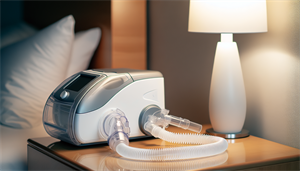Sleep apnea, a common sleep disorder, is often associated with a variety of health complications. But did you know that it could increase your risk of developing cancer? Yes, you read that right.
There’s an increasingly recognized link between sleep apnea and cancer, making this seemingly benign sleep disorder a serious health concern. Let’s delve into this intriguing connection.
Key Takeaways
-
Sleep apnea, especially obstructive sleep apnea, is linked to an increased risk of developing cancer due to intermittent hypoxia, which can lead to oxidative stress, inflammation, and DNA damage that may promote tumorigenesis.
-
Various types of cancers such as lung, breast, kidney, pancreatic, and melanoma have been associated with sleep apnea, with evidence suggesting this link may be due to the common features of hypoxia and inflammation found in sleep apnea patients.
-
Effective diagnosis and treatment of sleep apnea are critical for reducing cancer risks, involving options such as CPAP therapy and lifestyle modifications like weight loss, increased physical activity, and avoidance of alcohol and tobacco.
The Link Between Sleep Apnea and Cancer

Sleep apnea, particularly obstructive sleep apnea, is more than just a sleep disorder leading to daytime sleepiness and loud snoring. It could potentially be a harbinger of severe health issues, including cancer. A higher incidence of severe obstructive sleep apnea was observed in cancer patients, hinting at a higher propensity for tumor development in these individuals. But what exactly ties sleep apnea to cancer? The answer lies in hypoxia, inflammation, and oxidative stress.
The development of tumors could potentially be triggered by intermittent hypoxia, a common occurrence in sleep apnea patients. This process involves:
-
the production of transcriptional mediators of hypoxic and inflammatory responses
-
leading to increased oxidative stress, inflammation, and DNA damage
-
which could then pave the way for tumorigenesis.
Simply put, the development of cancerous cells could ultimately be the result of a chain of biological reactions set off by fluctuating oxygen levels experienced by sleep apnea patients. This revelation underscores the need for proper diagnosis and management of sleep apnea, not just to ensure good sleep but also to keep serious health conditions like cancer at bay.
The Role of Hypoxia
Hypoxia, characterized by low oxygen levels, is a common feature in sleep apnea patients. Receiving a lot of attention in the medical world, this condition is believed to significantly promote tumor growth and the development of cancer. Understanding how hypoxia leads to cancer requires a deeper delve into the cellular level.
Cancer development is a complex process involving several factors. Hypoxia, however, seems to have a role in stimulating the formation of new blood vessels, a process known as angiogenesis, within cancer cells. This process is further influenced by intermittent hypoxia, a characteristic of sleep apnea, thereby indirectly promoting tumor growth and metastasis and potentially increasing cancer incidence.
At a cellular level, hypoxia facilitates tumor growth through various mechanisms, including:
-
stimulating angiogenesis
-
altering gene expression
-
suppressing apoptosis
-
promoting inflammation
These processes are often seen in sleep apnea patients and could potentially contribute to the elevated cancer risk factors, which might be linked to sleep apnea increased incidence.
Inflammation and Oxidative Stress
Alongside hypoxia, sleep apnea could also lead to inflammation and oxidative stress in the body, thereby increasing the risk of cancer. The question arises - what triggers this inflammation and oxidative stress in sleep apnea patients? The primary culprits are chronic intermittent hypoxemia and disturbed sleep, both of which are common features of sleep apnea.
But how does inflammation and oxidative stress lead to cancer? The answer lies in the disparity in the generation and buildup of reactive oxygen species (ROS) within cells. This disparity, exacerbated by the intermittent hypoxia experienced during sleep apnea episodes, could lead to increased oxidative stress, thereby potentially paving the way for the development of cancer.
The connection between sleep apnea, inflammation, oxidative stress, and cancer is complex and multifaceted. However, understanding this link can provide valuable insights into the potential health risks associated with sleep apnea, underscoring the need for appropriate diagnosis and management of the sleep disorder.
Types of Cancers Associated with Sleep Apnea

The link between sleep apnea and cancer isn’t confined to a single type of cancer. Evidence suggests that sleep apnea is linked to various types of cancer, including:
-
lung
-
breast
-
kidney
-
pancreatic
-
melanoma
The presence of sleep-disordered breathing among cancer patients provides further evidence of this link, with obstructive sleep apnea being associated with an elevated likelihood of developing certain cancers, including lung cancer.
Research also points towards a potential correlation between obstructive sleep apnea and breast cancer. Studies have indicated a higher cancer mortality rate among obstructive sleep apnoea patients for certain types of cancers, suggesting that sleep apnea could potentially contribute to the risk of breast cancer.
The prevalence of kidney cancer is also observed to be higher among sleep apnea patients. Moreover, the link between sleep apnea, particularly obstructive sleep apnea, and pancreatic cancer is substantiated by evidence indicating a heightened occurrence of gastrointestinal cancers in sleep apnea patients.
Lung Cancer

There’s a notable link between sleep apnea and lung cancer, with individuals exhibiting an apnea-hypopnea index (AHI) of ≥15 being at a 3.4 times higher risk of developing lung cancer. This link is primarily attributed to hypoxia and inflammation, both of which are common features of sleep apnea.
Hypoxia, particularly nocturnal hypoxia, is regarded as a potential contributing factor to lung cancer development. Studies have noted that lung cancer patients often experience:
-
Nocturnal hypoxemia
-
Apnea
-
Snoring
-
Daytime sleepiness
more frequently compared to control groups. The role of obstructive sleep apnea and its associated chronic intermittent hypoxia in lung carcinoma progression further underscores the potential link between sleep apnea and lung cancer.
Similarly, inflammation resulting from sleep apnea has also been linked to an elevated risk of lung cancer. This link between sleep apnea, hypoxia, inflammation, and lung cancer underscores the importance of early detection and intervention of sleep apnea.
Breast Cancer
The potential link between sleep apnea and breast cancer has also garnered considerable attention. Several studies indicate a possible correlation between the two, although the exact relationship is still under investigation and remains incompletely understood.
Intermittent hypoxia in sleep apnea patients may be associated with promoting breast cancer survival and increased tumor growth. Moreover, the inflammation and oxidative stress associated with sleep apnea can exacerbate DNA damage and tumorigenesis, thereby increasing the risk of breast cancer.
Understanding the potential link between sleep apnea and breast cancer can provide valuable insights into the health risks associated with the sleep disorder. This understanding underscores the need for proper management of sleep apnea to mitigate these risks.
Diagnosing and Treating Sleep Apnea

With the potential health risks associated with sleep apnea, including an increased risk of cancer, it is crucial to diagnose and treat this sleep disorder effectively. Recognizing the signs and symptoms of sleep apnea can lead to a timely diagnosis. These signs and symptoms include:
-
Daytime fatigue
-
Excessive daytime sleepiness
-
Loud snoring
-
Observed episodes of stopped breathing during sleep
A sleep study, or polysomnography, is often used to diagnose sleep apnea. This test monitors:
-
Heart, lung, and brain activity
-
Breathing patterns
-
Arm and leg movements
-
Blood oxygen levels during sleep
This provides a comprehensive picture of the individual’s fragmented sleep health, which can be improved with the right sleep med.
Positive airway pressure (PAP) therapy, considered the most effective method for managing sleep apnea, is typically the treatment of choice once the disorder is diagnosed.
Sleep Studies
A sleep study, or polysomnography, serves as the primary method for diagnosing sleep apnea. It is a comprehensive test that thoroughly assesses your sleep by recording brain waves, heart rate, and breathing patterns during sleep. This information is then used to ascertain whether or not you have sleep apnea.
The equipment used in a sleep study for sleep apnea includes:
-
A breathing sensor such as a nasal cannula or nasal prongs
-
A sleep data monitor
-
A heart rate finger sensor
-
An adjustable chest strap
The information gathered from these tools allows healthcare providers to accurately diagnose sleep apnea and determine its severity.
The Apnea Hypopnea Index (AHI), which signifies the frequency of apnea and hypopnea events per hour of sleep, is an important metric used to determine the severity of sleep apnea during a sleep study.
Treatment Options
Upon diagnosis, it becomes critical to treat sleep apnea effectively. The most commonly used treatment for sleep apnea is continuous positive airway pressure (CPAP) therapy. This treatment involves:
-
Delivering a continuous flow of air to gently open the airways
-
Preventing their collapse
-
Enabling normal breathing and sleep patterns throughout the night.
Apart from CPAP therapy, there are a variety of alternative treatments available for managing sleep apnea. These alternatives include:
-
Various PAP machines
-
Oral appliances
-
Behavioral changes
-
Surgical interventions
Regardless of the treatment method chosen, adherence to the treatment plan and regular follow-ups with healthcare providers are crucial for ensuring effective sleep apnea management and reducing related health risks, including cancer.
Reducing Cancer Risk in Sleep Apnea Patients

Being diagnosed with sleep apnea isn’t tantamount to a death sentence. With proper management and healthy lifestyle choices, it’s possible to reduce the risk of cancer in sleep apnea patients. These lifestyle choices include:
-
Weight loss
-
Increased physical activity
-
Cessation of alcohol and tobacco use
-
Avoidance of specific medications
-
Alteration of sleep position
-
Use of a dental device
-
Treatment of nasal congestion
-
Adherence to a healthy diet
Not only can weight loss decrease the severity of sleep apnea, it can also decrease the likelihood of related health issues, such as cancer. Similarly, physical activity has been linked to a decreased risk of obstructive sleep apnea, which in turn is associated with an elevated risk of certain types of cancer.
Proper management of sleep apnea, along with adopting healthy lifestyle choices, plays a crucial role in reducing cancer risk. This involves following treatment plans and regular follow-ups with healthcare providers to ensure that the condition is well-controlled.
Healthy Lifestyle Choices
Adopting healthy lifestyle choices can go a long way in managing sleep apnea and reducing cancer risk. This includes:
-
Following a diet rich in monounsaturated fatty acids
-
Emphasizing vegetables and fruits
-
Consuming omega-3 animal products
-
Choosing lean animal protein
-
Eating raw nuts
Regular exercise can also be beneficial by assisting in weight management, lowering inflammation, and reducing the likelihood of developing specific types of cancer. Additionally, oropharyngeal muscle exercises, which help to strengthen muscles, are recommended to potentially decrease the risk of cancer.
For sleep apnea patients who smoke, quitting smoking is crucial for lowering their heightened risk of cancer. Strategies such as engaging in exercise, receiving regular vaccinations, and receiving counseling against the use of cigarettes and cannabis can be helpful in achieving this goal.
Proper Sleep Apnea Management
Managing sleep apnea effectively is crucial for reducing the risk of cancer. This involves using treatments like a continuous positive airway pressure (CPAP) device and implementing lifestyle changes such as weight loss and avoidance of alcohol and sedatives. Adherence to treatment plans, particularly CPAP therapy, can alleviate the impact of conditions associated with sleep apnea and potentially lower the likelihood of new cardiovascular incidents, thereby reducing cancer risks.
Regular follow-ups play a crucial role in evaluating potential complications related to OSA management and in monitoring the effectiveness of the treatment, which may involve follow-up sleep studies if deemed necessary. Sleep apnea patients are advised to schedule appointments with their healthcare providers:
-
Within three months of diagnosis and treatment initiation
-
Subsequently at least annually
-
More frequently in the event of symptom changes or treatment challenges.
The Importance of Early Detection and Intervention
Prevention of long-term health issues, including cancer, can be achieved through early detection and intervention of sleep apnea. A timely diagnosis can be made by recognizing the signs and symptoms of sleep apnea, such as:
-
severe fatigue
-
daytime drowsiness
-
irritability
-
difficulty concentrating
-
loud snoring
-
gasping or choking during sleep
-
morning headaches
-
dry mouth or sore throat upon awakening
-
restless or fitful sleep
-
problems with memory or concentration
Delayed detection or absence of treatment for sleep apnea, also known as sleep apnoea, can result in significant complications, such as:
-
daytime fatigue
-
heightened risk of hypertension and obesity
-
challenges in blood pressure regulation
-
potentially fatal consequences
Hence, timely diagnosis and treatment are imperative.
Benefits of Early Diagnosis
Early diagnosis and treatment of sleep apnea can significantly reduce the risk of developing cancer and improve overall health. Early detection can result in various advantages including:
-
Enhanced cardiovascular health
-
Decreased likelihood of stroke
-
Improved cognitive abilities
-
Reduced risk of accidents
-
Enhanced life expectancy
-
Avoidance of detrimental health consequences
-
Prevention of complications
-
Overall better health
A delayed diagnosis of sleep apnea can have severe consequences, including obstructive sleep apnea severity, which may lead to:
-
Fatigue
-
Cardiovascular issues
-
Mood alterations
-
Disruptions in cognitive function
-
Heightened risk of mortality
-
Enduring effects such as heart disease, type-2 diabetes, and liver and kidney complications.
The success rates of sleep apnea treatment exhibit variability. However, with CPAP treatment, patients diagnosed with moderate OSA can observe a significant reduction in their AHI, resulting in a success rate of 69%. Furthermore, at a 2-year follow-up, the success rates were 93.1% for MAD treatment and 100% for CPAP treatment.
Seeking Medical Help
Recognizing sleep apnea symptoms and seeking medical help is crucial for early detection and intervention. This can ultimately decrease the risk of cancer and other health complications. The initial signs of sleep apnea, such as:
-
severe fatigue
-
daytime drowsiness
-
irritability
-
difficulty concentrating
-
loud snoring
-
gasping or choking during sleep
-
morning headaches
-
dry mouth or sore throat upon awakening
-
restless or fitful sleep
-
problems with memory or concentration
should prompt individuals to seek medical assistance.
If an individual suspects they have sleep apnea, they should consult a sleep specialist, a cardiologist, or an otolaryngologist (ear, nose, and throat doctor). Typical diagnostic tests for sleep apnea include polysomnography (PSG) and nocturnal polysomnography in a sleep laboratory.
Promptly seeking medical assistance for sleep apnea can result in:
-
Swift alleviation of symptoms
-
Better overall prognosis
-
Decreased breathing interruptions
-
Enhanced sleep quality
-
Reduced health risks linked with sleep apnea
Summary
In summary, sleep apnea, a common sleep disorder, is more than just a nuisance that disrupts sleep. It’s a serious health concern that has been linked to an increased risk of various types of cancer, including lung and breast cancer. The connection between sleep apnea and cancer is multifaceted, involving factors such as hypoxia, inflammation, and oxidative stress. Understanding this link is crucial for the effective management of sleep apnea and the reduction of cancer risk. Early detection, intervention, and adherence to treatment plans, along with healthy lifestyle choices, can significantly reduce the risk of cancer in sleep apnea patients.
Frequently Asked Questions
What cancers are associated with sleep apnea?
People with sleep apnea have a higher risk of developing certain types of cancer, including lung cancer, prostate cancer, and melanoma, due to higher levels of oxygen deprivation during sleep.
What is the average age of death for sleep apnea?
The average age of death for sleep apnea is around 62 to 66 years, with mortality rates increasing with the severity of the condition. Sleep apnea can significantly impact life expectancy, particularly in severe cases.
How long will it take to reverse damage from sleep apnea?
Treating sleep apnea with CPAP for just 12 months can almost entirely reverse damage done to white matter, improving sleep and symptoms while decreasing the risk for cognitive issues.
What are the diseases caused by sleep apnea?
Sleep apnea can lead to various health issues such as type 2 diabetes, high blood pressure, heart disease, and strokes, ultimately impacting the individual's lifespan. These conditions are associated with the severity of obstructive sleep apnea.
Symptoms of sleep apnea?
If you experience warning signs like loud snoring and daytime fatigue, it could be a symptom of sleep apnea. Additionally, symptoms of obstructive sleep apnea include pauses in breathing during sleep.


